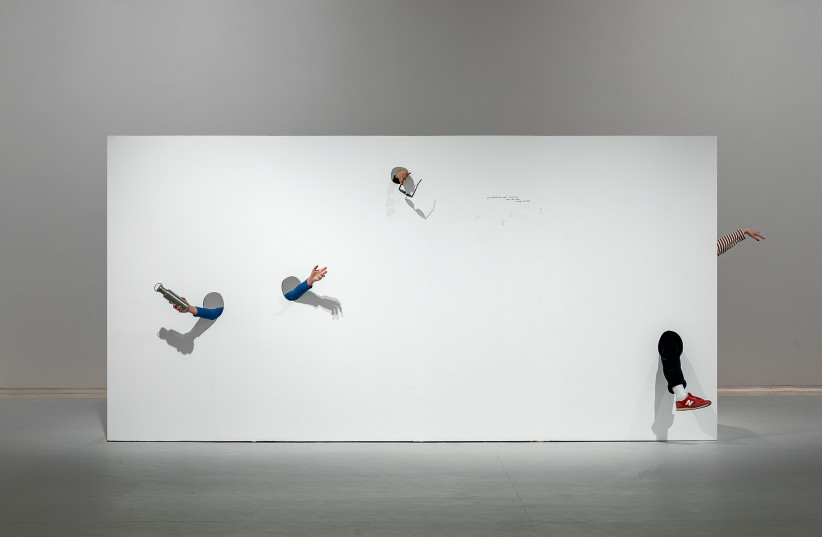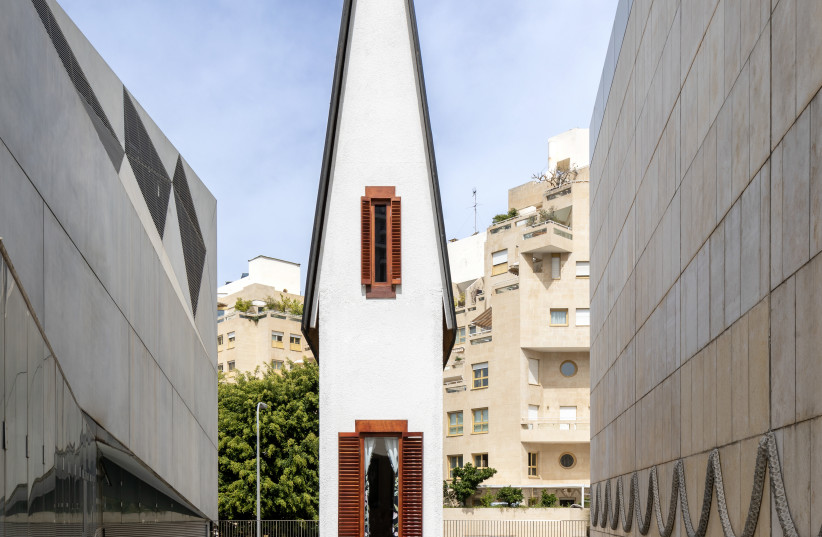The Tel Aviv Museum of Art presents Away at Home, the first solo exhibition in Israel of works by internationally renowned contemporary artist Erwin Wurm.
Wurm was born in 1954 in Bruck an der Mur, Austria. He gained his fame in the 1990s with his One Minute Sculptures series, in which he subjected himself, performers and the viewers to paradoxical or sometimes absurd situations that re-examine our usual forms of behavior and acquired habits as he touched upon essential existential questions. By giving simple instructions, Wurm encouraged the audience to participate in his art and to be mindful.
An earlier version of One Minute Sculptures, now on view at Tel Aviv Museum of Art, was used in the Can’t Stop video clip by rock band Red Hot Chili Peppers. Wurm laughs “Yes, I was the first artist who was ever credited by a band. Normally in music videos on MTV, the artwork is never credited; it was stolen from the artists. So when the director Mark Romanek called me, I was very surprised. I must admit, I didn’t know the band, but everyone in my studio got very excited. And the musicians followed the instructions on the sculptures. It was fantastic!”
At TAMA, in addition to the new set of One Minute Sculptures, Wurm presents a massive outdoor sculpture titled Narrow House, a replica of Wurm’s childhood home squeezed into a 1.1m. width and pivoted at an unusual angle. The piece, he says, refers to the bourgeois narrow-mindedness of post-war Europe.
Wurm has exhibited his artwork widely since the 1990s and represented Austria to great acclaim at the Venice Biennale in 2017. He is known for his unique approach to sculptural practice: broadening the traditional notion of sculpture and reinventing it through performance art, video, photography, and drawing, demonstrating that any material of everyday life can be the beginning of an art sculpture and that there are no limits as to where artwork can be presented – from art galleries and the world’s top museums to St. Stephen’s Cathedral in Vienna to a music video clip of the Red Hot Chili Peppers.
In the followinng interview with Wurm, he talks about the connection between biology and technology in his art, which, he says, could soon become the reality of our lives.
Wurm started creating One Minute Sculptures in the early 1990s. The sculptures include instructions for the viewers, who are expected to interact with them. Eurm says that it all started when he was not accepted to the pinting class. “I wanted to become a painter, but I wasn’t accepted to the painting class at the Academy of Art; they put me in the sculpting class. I was frustrated with it, but I decided to try it; I treated it as a challenge. But I had no idea what sculpture was. So I started to research it: from two to three dimensions, skin, volume, space, time. I realized that the act of doing became very important to me, not just the result of it.”
Do you mean the process?
"The process, yes. On the other side, I was trying to find equivalence to our short lifespan, so that was the second component [of One Minute Sculptures]. The third component was that during my research, I realized that any material in our daily lives, including our thoughts and ideas, is possible material for a sculpture. To manifest this, I started the One Minute Sculptures, where ‘one minute’ is really a short period of time, a moment.”
How did you manage to follow through with this? How did you convince others to exhibit it?
It was very complicated. I also wanted to earn a living from my work, and you cannot sell an idea, an ephemeral happening, so I started to photograph them. For the exhibitions, where we invited people to follow my instructions, we used a Polaroid camera.”
At the exhibition, there are instructions, such as ‘Put your head under the lamp.’ ‘Put your leg in a hole.’
“The first idea was to give instructions for people to help them understand the piece. But then immediately I thought – as I was an avid reader of literature, history, philosophy and psychology – that I wanted the information I was collecting through reading to be included in my art, by changing the volume and changing the content of my sculptures. So I started to give people hints.”
There is a lot of mindfulness in experiencing your work. Is that your intention?
“Yes, it is. I want people to notice what they experience. And my art is not funny. I use paradox and the absurd, but I don’t like when people think it is funny because funny is cheap.”
Each series of One Minute Sculptures is different. The furniture used in the Tel Aviv exhibition were made here. What were you looking for and what did the process of preparing this exhibition look like?
“I asked Mira and Amit [curator Mira Lapidot; assistant curator Amit Shemma] to look for furniture from the 1950s, ‘60s and early ‘70s. This took months; they were sending me pictures, and I selected them. The ‘50s was the first time that designers started to design for working-class people, for the common people. Also in the ‘50s, we believed in a great future. We believed in a positive future. Today, we are lacking a belief in the future because the future is a threat. So I want to reflect on it. But also here it is different because Jews were kicked out of Europe and were killed. So in the ‘50s, Jews were looking for a new future, while Europe was still looking back to the past."
So because of the history, is this a different experience for you to present the exhibtion in Israel?
“Yes, absolutely. I like Israel, and I like Jews because they are so intellectual, great in business, and great artists, musicians. Tel Aviv is amazing, so open-minded.”
You grew up in post-WW II Austria, which, as I read, you consider narrow-minded. How did you transfer, not only your personal story but the wider picture, to your art?
“Narrow House, for example, is a replica of my parents’ house, where I grew up. The upper window was my bedroom window. The house looks exactly the same but is only 1.1m wide. There are old photos and specific furniture from the 1950s, ‘60s and ‘70s related to the specific times, to the post-war bourgeois European narrow-mindedness. It was a narrow society – narrow-minded. So I thought it was important to show it In order for us to reflect on the societies we are living in. I thought it was interesting to show the parallel. Austrian society is better now than back in the ‘50s but still not good. And not just the Austrians.”
Reserching your biography, the only thing I found about your childhood was that your father was a detective, and was against artists. Now you drag his life all around the world…
“I love, I loved my father. We made peace eventually, but we had many fights. As a policeman, he was afraid that I would become an artist with no money and no pension. That was important. He was not interested in art or literature, but he was a loving father. In the end, he was proud.”
Art was your own path. For other artwork, you discovered cars and clothes as art. How did these become your sculptures?
“In the past, everyone liked their cars. Cars gave them power, status; everybody wanted to show off. Now cars are not beloved objects anymore because of pollution; they destroy our world. I started the fat cars over 20 years ago, and their perception has changed completely. People get fat; we change form, just like sculptures. So we as people constantly change content; we are the first sculptures. I wanted to connect it with the technical content of a car. We mix biology and technical things, and maybe this will be the future. We will have electronic parts in our bodies very soon.”
And your clothes sculptures?
“We buy clothes, and they can change our role, change a personality. Clothes are the second layer of skin. When you look back at Greek and Roman artwork, skin was always important. Clothes can protect us. You can play with it, so I started to create sweaters that protected houses, for example, or cars. And then they called me from the biggest church in Vienna, St. Stephen's Cathedral, a beautiful Gothic church, to make something for them. I covered the high altar with a sweater [of 80 sq. m.] before Easter. Many people hated it.”
I read that you said, ‘It’s about the difficulty of coping with life, whether it is with a diet or philosophy.’ Please elaborate.
“Starting with Epicurus, we all desperately try to have a happy life. The question is: How do you do this? It is very personal. Do we want to have a peaceful life or fight for something? I chose to fight for my art. So I don’t have a peaceful life, but I have a great life.


